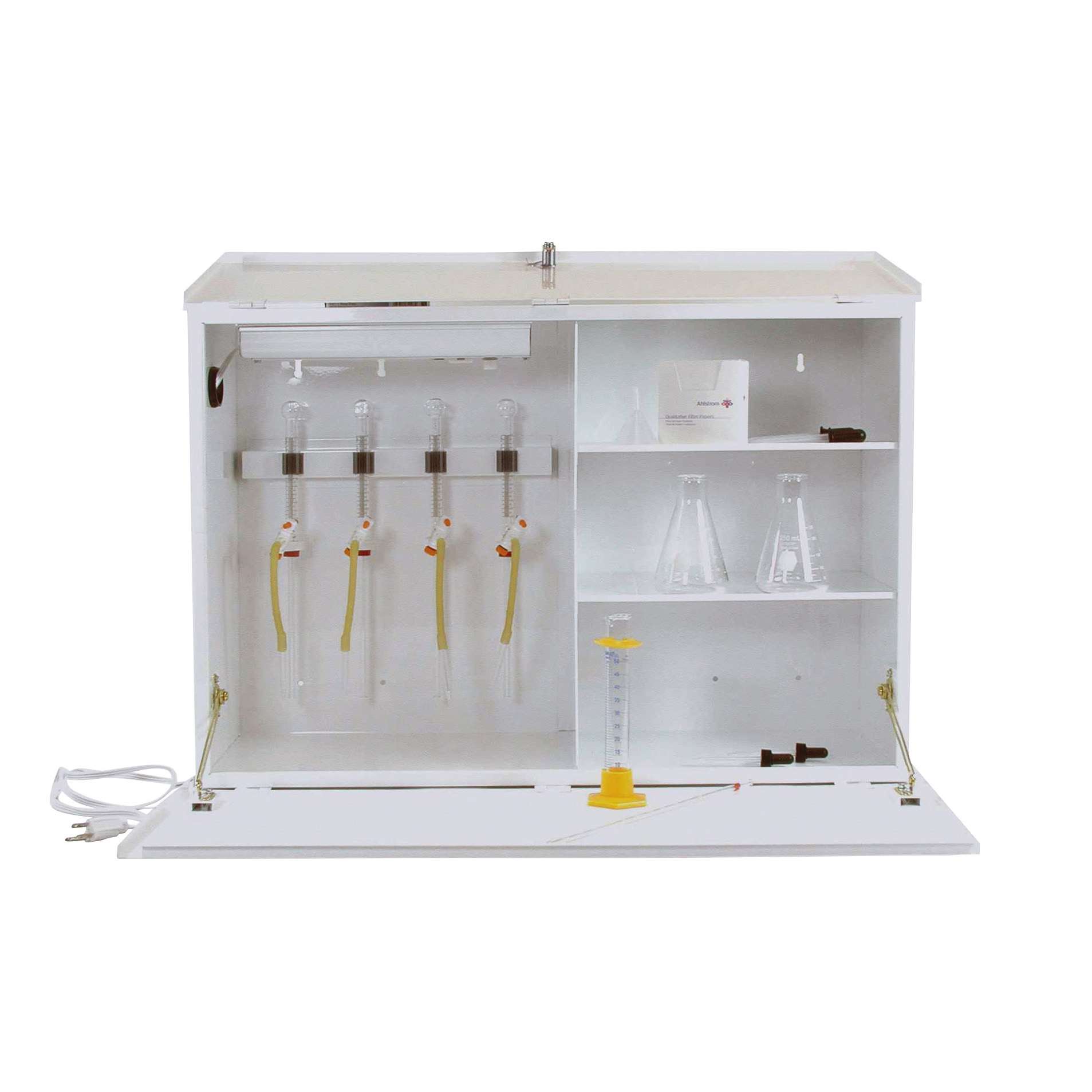Deciding Whether To Use A Drop-Count Or Buret Titration
Drop-count or buret titration: which to use? This is a question some newer reps face. More seasoned water treaters were probably taught the basic tests (hardness, alkalinity, chloride, and sulfite) using burets alone. So which testing option is appropriate when?
Some water treaters would do buret titrations all of the time for their greater sensitivity. Even with burets reading in 0.1 mL increments, one can titrate high analyte levels quickly. And the accuracy of Taylor’s buret titrations is ±2% or better. However, glass burets require more careful handling than plastic dropper bottles do, and they take more time and room to set up. It can be hard balancing a testing setup on 55-gallon drums in the utility room of a customer who does not have a lab. (Consider getting some wall-mount cabinets like the K-9780 pictured below.)
Our buret titration reagent packs contain all the reagents and instructions necessary to perform a given test, shipped in a cardboard carton instead of a plastic carrying case. These include two alkalinity tests; three chloride tests; a free and combined chlorine test; a test for calcium, magnesium, and total hardness; a nitrite test; a phosphonate test; and four sulfite tests.
Drop tests are simple, quick, and, generally, less expensive than their buret brethren. The carrying cases are more manageable than our portable titration case (K-9348), and their contents are rugged, making drop tests better suited for work outside the lab. Ours offer accuracy of ±10% or better, ample for most field applications. However, when analyte levels are very high, you may be counting a lot of drops…or sacrificing sensitivity to use a smaller sample-volume/higher drop equivalence.
Taylor offers drop tests for 24 analytes including mainstays like hardness, alkalinity, chloride, and sulfite. Most kits contain reagents in 2 oz. bottles and recently have been upgraded to have the bottle caps color-coded to the test instruction. Endpoint colors are pictured.
Ultimately, the answer to the question of buret vs. drops lies in recognizing what the system requirements are. Here's where we think spending the extra effort and pennies on buret titrations is justified:
- Large cooling water systems that require significant amounts of chemical treatment where you therefore have higher stakes in the game.
- Cooling water systems that cool valuable processes. Again, high stakes.
- Cooling water systems whose chemistries tend to be stressed and at the operating limit of the treatment program. These require more precise control.
- Cooling water systems where the make-up water chemistries change significantly enough to affect treatment dosage levels or system performance.
- Higher-pressure boiler applications that require better control and may be carrying lower sulfite residuals (due to the higher pressure).
- And, finally, accounts who perceive their systems are important enough to their processes to warrant the extra precision (higher stakes argument again).
In other circumstances, drop tests probably make more sense. Remember, you can vary a test's drop equivalence by using a different sample size. There's a how-to article in this Learn More/Chemistry Topics section called "Modifying the Recipe for Industrial Water Testing," if you’re interested. You also can change the drop equivalence by using a different-strength titrant. For example, sulfite is 1 drop = 2 ppm using R-0808 but is 1 drop = 10 ppm using R-0699.
Feel free to call or e-mail our Customer Service group if you have questions about performing either type of titration.
Buret Equipment Options
| KIT NO. | KIT NAME | CONTENTS |
|---|---|---|
|
K-9780 |
Wall-Mount Titration Cabinet, |
20-gauge cold-rolled steel with baked enamel finish, built-in Dalite™ lamp, work area for four buret titrations, three storage shelves, lockable (photo below) |
|
K-9780-GP |
Wall-Mount Titration Cabinet Glassware Pack |
One 50-mL graduated cylinder, two 250-mL Erlenmeyer flasks, one 10-mL glass pipet, one 58-mm plastic funnel, two 1.0-mL plastic pipets, two 3-mL plastic pipets, four 10-mL stopcock burets, #610 9.0 cm filter papers |
Wall-Mount Titration Cabinet (K-9780) Outfitted with Glassware Pack (K-9780-GP)
(purchase pintsize reagents separately)


